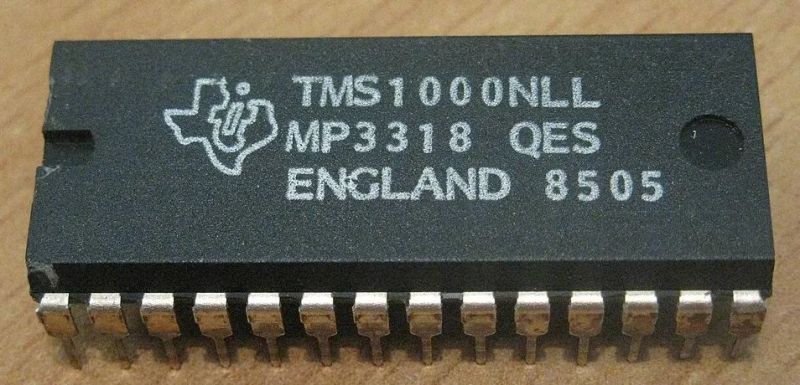
Although for most generations alive today the era of microcontrollers (MCU) feels like it starts somewhere with the Intel 8051 and AVR MCUs, the history of these self-contained computing marvels that are now found just about anywhere begins long before those were even conceptualized. In a recent article titled Tiny Computers From Texas, [Babbage] goes through this early history of what would ultimately become such an integral part of daily life.
An MCU is defined as a small, self-contained computer, which requires few to no external components to function. This contrasted with the more traditional MPUs, or microprocessor units, where a computer was assembled out of one or more MPUs, I/O chips, memory SRAM and so on. It’s perhaps little surprise that the drive towards MCUs was the result of primarily the calculator market, where competing firms were trying to upstage each other with higher levels of integration into as few chips as possible, while driving down costs and power usage.
Ultimately, the Texas Instruments TMS 1000 was the first true MCU that got produced in large volumes after its release in 1974. Moving beyond calculators, the TMS 1000 found its way into toys, including the Speak & Spell – which uses another Ti chip (TMS 5100) for the voice synthesis – so that today any toy can be interactive in exciting and often noisy ways.
Back in 2020 we took our own affectionate look at this chip.
















Interesting!
Thanks Maya!
On the high-end side of the TMS 1000 series was the TMS 1600. A nice application was the Busch Microtronic Computer System: https://github.com/lambdamikel/Busch-2090 ;-)
If you can read German, here is an interesting document describing how complex TMS 1600 “firmware” (e.g., of the Busch Microtronic) was developed back in the day in 1979 / 1980.
The development system was EPROM-based and floppy disks were then sent to TI in Freising, Germany for a TMS 1600 production run. Described here, but in German:
https://github.com/lambdamikel/Busch-2090/blob/master/manuals/joerg-vallen-diplom.pdf
The exact kind of development system is unknown, but it may have been something like the
“HE-2 TMS Hardware Emulator” described on Page 37 / Chapter 7 in this document: http://www.bitsavers.org/components/ti/TMS1000/TMS_1000_Series_Data_Manual_Dec76.pdf
Is England in Texas? I thought it was somewhere in Europe, but could be wrong.
Hi Babbage – who wrote the original – article here. Texas Instruments had a manufacturing base in England until the 1990s in a town called Bedford, hence some of the TMS 1000 series MCUs were labelled as England.
No horse in this race, but surprised no one took exception to the implication England was in Europe somewhere.
Hi Maya, Babbage here! Thanks for linking to my post.
Could you please fix the title of my post though. It’s ‘Tiny Computers from Texas’ rather than ‘Little Computers from Texas’. Thanks!
AVR was 1996. I was programming PIC’s for keyless remote and patient tracking in 1991 and General Instruments made them well before that. They did development on it in 1975. Like AVR, it was also Harvard arch. Microchip continued the PIC arch after GI.
Matter of fact is that TI invented the Microcontroller, and they hold the patent on it (it was granted years later – US Patent 4074351, 1978).
No question about that. AFAIK TI was first with monolythic integrated microcontroller. Just pointing out one of the other early efforts in that space. And there were others.
growing up in dfw in the 60’s school literally was ricket science and radioshack based there in ft worth and ti in dallas it was really hard to not stick stuff to each other and watching what happened from hamm to control data to ibm with eagle trs and compaq on all sides…thanks for the memories…67 rides around the star so far and still so much soldering left to do lol
Wish living in Texas was still like that. I had a bit of it in my childhood thanks to my dad keeping some of his old stuff around from the NASA days
“Wish living in Texas was still like that.”
Now you never leave home without your bible and must
beat your wife once a day.
Wow. You must be fun at parties.
The great thing thing is *you* don’t have to be there.
TMS1000 NLL MP3318 Was also a 24 melodies siren sold in France in 80/90″s that was like this: https://u-electronique.com/forum/attachment.php?attachmentid=27873&stc=1&thumb=1
Curious what disqualifies the i4004 from this category l.
Microcontroller != Microprocessor
It’s a bit like the logic used to claim that Orville and Wilbur Wright developed the first airplane: just define “modern airplane” as “what Orville and Wilbur Wright built” and you can claim to be first.